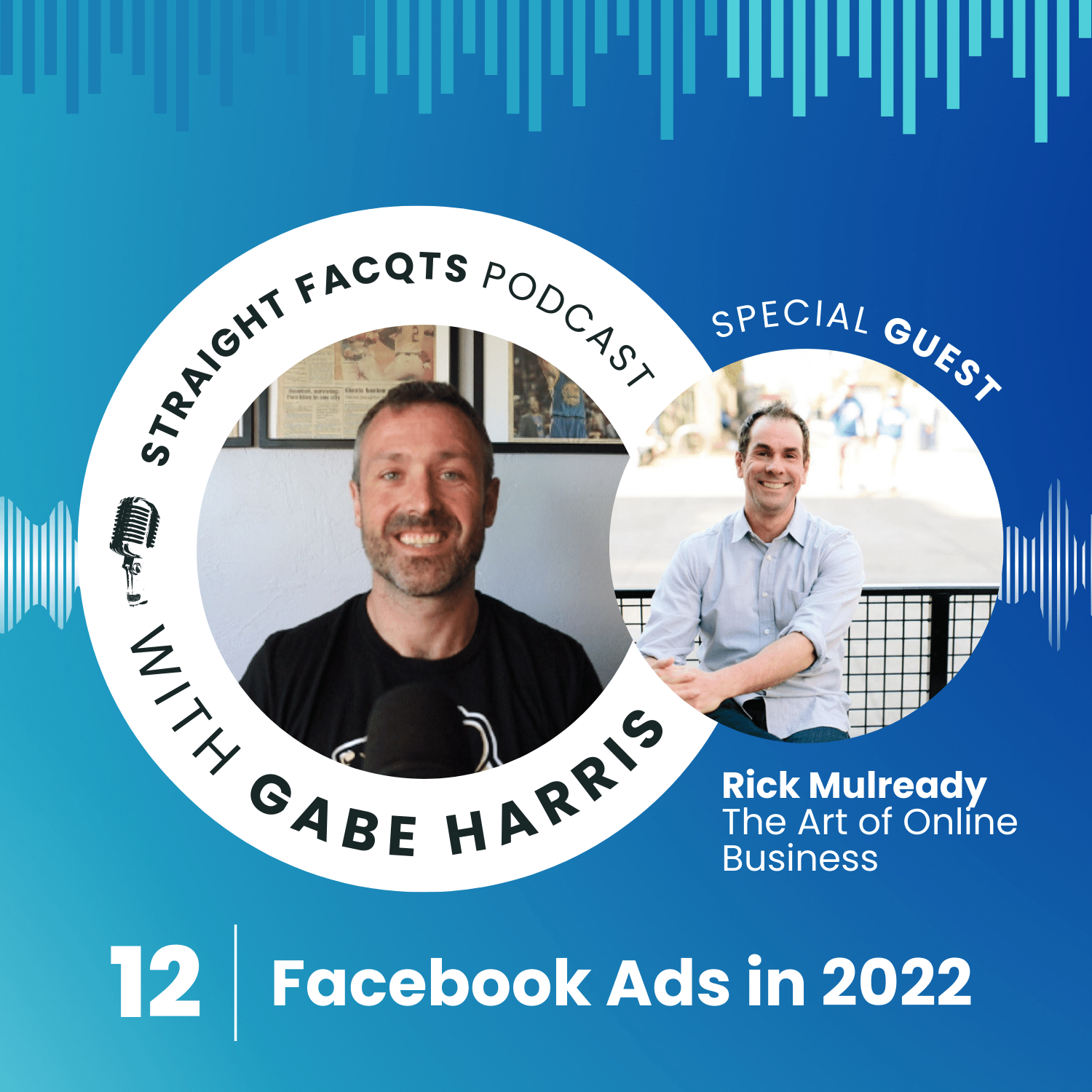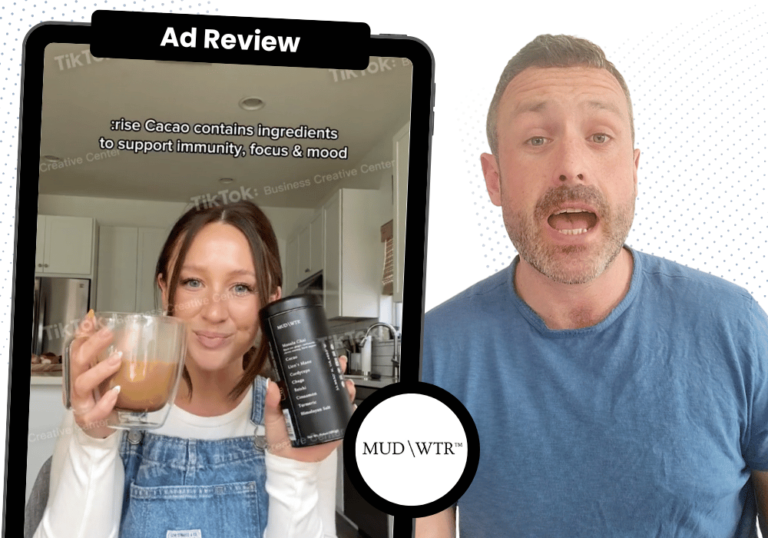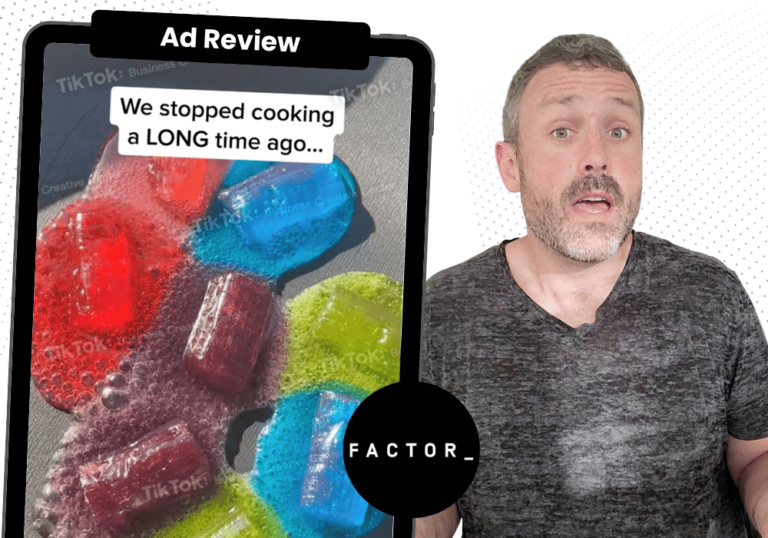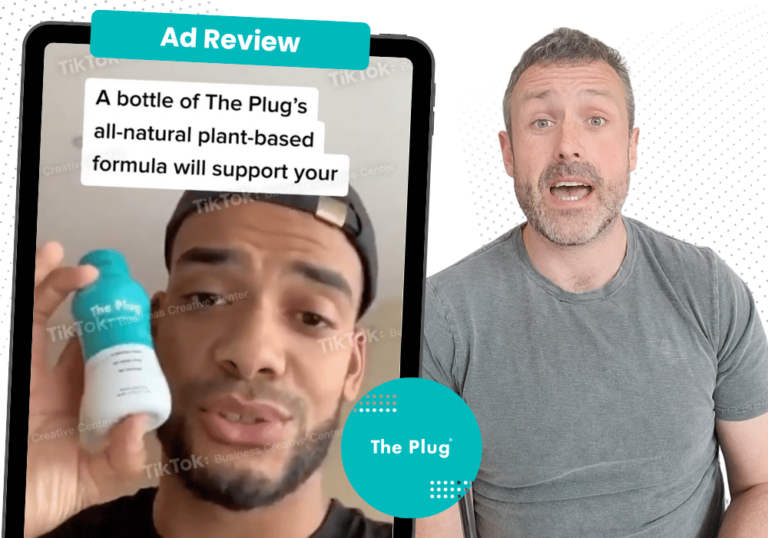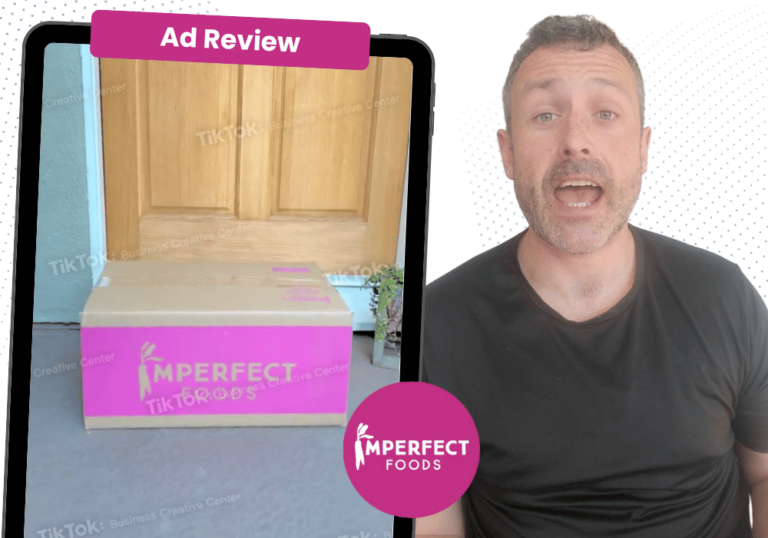On this episode of Straight Facqts, we’re talking to Facebook ads expert, Rick Mulready, and we get deep into Facebook ads in 2022, lead generation forms, TikTok and how powerful creative is for social media advertising. Let’s get into it!
Gabe Harris:
I thought a cool thing to be able to talk about is, you used to be knee-deep into Facebook ads, and I imagine obviously you still are, but it looks like you’re pulling back a little bit from going to more of a 10,000 foot analysis for businesses.
So, you can be able to actually take a look at full-funnel Facebook ads, optimize there and I imagine, optimize all paid channels organically, more of a strategic standpoint?
So we’d love to learn how your idea of Facebook ads has evolved, say, over the past year or two.
Rick Mulready:
The success of your Facebook ads hinges on: Number one, you got to have a good offer. If you have a crappy offer, the best creative, the best ad campaign set up, isn’t going to do anything. So you’ve got to have a great offer, and then it’s just about testing creative.
The reason for it is because the targeting has gotten so much broader. They’ve taken away so many interests. You can still get targeted, but the audience size that you really need to target is so much bigger than it used to be.
Years ago it was like, “All right, we can get away with 100,000, maybe half a million people.” Whereas you need to be doing at least a couple of million people, at least.
And when you have that broad an audience and we’re now relying so heavily on Facebook’s AI or the algorithm to find us the people that we want to be reaching, it comes down to the creative.
“Our creative has to speak to the people that we want to pull out of the overall audience.”
Our creative has to speak to the people that we want to sort of, quote, unquote, “pull out, if you will” of the overall audience. And so that’s the biggest change that has really gone on, not to say the whole attribution thing is completely different than it used to be.
Whereas, before you could be like, “All right, you know what? I’m going to rely pretty heavily on the metric or the stats that Facebook is showing me on the ads manager.” Now you can trust, pretty much, how much you spend? Maybe your click-through rate and that’s about it. You know what I mean?
Because the data is so skewed and basically at this point it’s modeled data. They’re just taking, again, the machine learning, what they see from all the campaigns and stuff and the performance of your camp.
They’re modeling out the results that they’re giving you. And so you really have to, what I call triangulate the data, meaning, “All right, this is what Facebook is showing me. This is what my CRM is showing me.” Whatever, ConvertKit or active campaign. And then, “This is what my landing page software’s telling me.” Those three tools are not going to match up.
I mean, that’s no different than what it always was. They would never match up. However, you kind of have to take data from each piece and try to figure out what’s most accurate.
And that’s been one of the biggest differences and also one of the biggest frustrations, is like, “How do I know what’s actually working here and what my actual results are based on this data that I’m seeing?”
Gabe Harris:
Rick Mulready:
And that’s nothing new. Lead ads have been around for years and years and years. They used to be terrible in terms of the quality of the lead. A lot of people were like, “Oh my God, I got great lead costs using the lead ads.”
But the quality of the lead was really not good. Simply because of the fact that when you click on the ad… And for those people listening right now who don’t understand what a lead ad is, a lead ad as a user is, basically the ad looks no different than any other ad that you see in the Facebook feed or Instagram feed. And you click on the ad and the experience is right there within the ad unit. You don’t leave Facebook or Instagram, and it auto-populates.
It can auto-populate with your name and your email address or whatever information that you’re asking for.
In the past it’s kind of not been good at all because a lot of people use a throwaway email address. Right? On Facebook or what have you. So you could get cheap leads, but the quality of lead wasn’t very good.
Whereas, Facebook has done a lot of, I don’t know what they’ve done in the back end, but lead ads have done a whole lot better and you can do some different things with it, where you can turn off the auto-population of the fields.
“It’s what they call first-party data, meaning it’s all within the Facebook platform or Instagram and not leaving. So you can track all that data and all that data should be pretty accurate.”
So the experience is still within the ad unit but you can ask people to actually fill in their name and their email address. It’ll auto-populate, but you can have them confirm the information.
These are things that weren’t available in the past, just as an example, which make it a lot more of a quality lead. It’s what they call first-party data, meaning it’s all within the Facebook platform or Instagram and not leaving. So you can track all that data and all that data should be pretty accurate.
So they’ve made up a lot of advancements on the back end of lead ads, but again, they’re not brand new. But we’ve seen a lot more success over post-iOS because Facebook realizes that, “We gotta solve something here.” Because this affected them a lot more than I think they realized.
Gabe Harris:
Rick Mulready:
“Watch the feed, click on some ads and look at the experience.”
I love the experience of clicking on an ad, having the information right there. Meaning, all right, if I want to opt in for this lead magnet and it’s asking for my first name and email and it auto-populates and I can see it right there like, “Oh yeah, that’s the right information. Submit. Done.” You know what I mean?
I think that’s a really seamless experience. Just watch your feed in Instagram or if you’re on Facebook, still. Watch the feed, click on some ads and look at the experience.
The majority of the ads at least that I see in a lot of my students on Instagram are that experience. Meaning, I click on it, the information is right there, it’s populated, you confirm it and you’re done. And it’s a great experience. It’s really seamless.
Gabe Harris:
Rick Mulready:
Gabe Harris:
Rick Mulready:
Gabe Harris:
Rick Mulready:
It was kind of an upsell and it described the offer and then there was a call to action button and then that button took you off of Instagram over to the external landing page.
I liked it. I liked the experience, but I totally agree with what you’re saying Gabe, like, “All right, let’s have a video on that thank you page to continue the journey for that person.”
Gabe Harris:
Rick Mulready:
Gabe Harris:
Rick Mulready:
Gabe Harris:
So the best that I can be able to actually have them remember the brand, is for them to actually fill out the form. For me it’s going to increase not the likability but the possibility that they’re actually going to engage once they are interacting in that down funnel process.
Rick Mulready:
But yes, absolutely. I would trust your own landing page going into your email software, depending on what landing page you’re using. But I like that, I agree. I mean that it’s all about the speed, how quickly that follow up interaction can happen.
Gabe Harris:
Rick Mulready:
Gabe Harris:
Where if it’s a lead landing page and you’re asking 10 questions, that conversion rate is going to go significantly lower because of the amounts of questions you are asking.
Rick Mulready:
Gabe Harris:
Rick Mulready:
And I would just see her laughing in the evening time watching and I’m like, “Oh, she’s watching TikTok again.” She would show me, she’d be like, “Check this out.” And I, not using the platform, would be like, “Oh yeah, I don’t really get it.”
And then for some reason, literally when we’re recording this right now, the third week of August. Three weeks ago, beginning of August, something clicked where I started to watch the platform. And I started to consume content on there and I am completely hooked, on TikTok.
It is the first platform that when I’m done, when I shut my phone off and I’ve just watched a whole bunch of videos, I feel better, I laughed and I learned something. Literally I can check all those boxes pretty much every time I watch.
And how many social platforms can you say that about? And obviously the growth that it has seen and is seeing, I’m about to start doing just organic stuff on there. We have not yet jumped into the ad side, but I do know a lot of people who are doing TikTok ads right now and doing really, really well.
“The opportunity that exists with TikTok is huge.”
It is the Facebook of 10 years ago. It is still very much the infancy I think. And a lot of people think that TikTok is like, “Oh, just the younger creators. You have to go on there and dance and stuff like that or point, whatever.” That is so not true.
One of my accelerator coaching members is a TikTok expert. She’s got half a million followers or something like that. And one of the things that she said to me, that’s really stuck with me, I don’t remember the exact numbers but she said, “Oh, a massive amount, millions and millions and millions of people are of that older demographic, but no one realizes it because they’re not creating, they’re consuming.”
And so we as marketers need to understand that. That just because we don’t see the quote, unquote, “older” market creating content on there, doesn’t mean they’re not on there. They’re consuming content, they’re not creating.
And so from an ads perspective… Look I mean, Facebook and Instagram are, you see what’s been going on the past few weeks here with Instagram trying to change things up and be more like TikTok and then there’s this outcry of like, “What are you doing?”
They know that they’re losing a whole lot of ground. And I’m not saying that Facebook or Instagram ads are going anywhere, but the opportunity that exists with TikTok is huge.
Gabe Harris:
Rick Mulready:
Gabe Harris:
Rick Mulready:
I come across a whole bunch of ads on TikTok and I’m like, “That is a great ad.” Because it’s seamless to the rest of the content that I’m seeing and they pick up on trends or what have you. They’re doing a really good job.
And I think that the more of us that can create that sort of, and again, that’s not anything new. I mean, that really shifted on Facebook a few years ago where we ran tons of tests.
I had students running tests and it was, “All right, let’s do something that’s, quote, unquote, ‘professionally’ done on a DSLR camera versus grabbing my phone and shooting video.” And the phone content always outperformed the nicer looking video, so it makes sense. Right? Because it’s the type of platform that it is.
“When you can match the type of ad to the native content on the platform, that’s where you’re going to start winning.”
And you look at Instagram, for example. What are the best performing ads? Reels. Number one that’s, again, on your phone. I mean, granted there, they’ve been going towards video for forever.
But reels, stories, the newsfeed ads, I mean, yeah they work for people for sure, but it’s about reels. Right? So when you can match the type of ad to the native content on the platform, that’s where you’re going to start winning.
Gabe Harris:
Because setting up, I actually think setting up the Facebook ads is really relatively simple. The algorithm takes a hold of it. But what would you recommend when somebody’s looking to be able to make creative? Because that’s such a dynamic platform. Especially video, it’s such a dynamic expression.
Where do you even start with making videos?
Rick Mulready:
Gabe Harris:
Rick Mulready:
You have to understand the person that you’re trying to help. What do your people need? What’s going on with your person, if you will. How do you uniquely solve that problem? Are you speaking to those things? And I say those things, meaning are you speaking directly to your person?
And again, there’s nothing sexy about what I just said, but so many people do not get this right. You’d be surprised at very successful businesses from a revenue perspective. You dive into their business and it’s like, “Holy cow, this person isn’t even speaking to their target audience.” That is, what it’s all about.
Once you have that understanding, then you can create creative where you’re speaking directly to them.
“The best YouTube videos call out what the problem is and then they let you know what the video is going to be about.”
Whether it’s copy and people use the word “hook.” I like to say, what angle are you taking?
You should have three to five, at least, different types of angles. And all I mean by that is you’re using the first couple of lines, the first to three lines of your copy to get your target person’s attention, and you’re testing different ways to do that.
If you do a video, it’s the exact same concept where you’re using different angles at the top of the video to get their attention.
It’s just like watching a YouTube video. The best YouTube videos call out what the problem is and then they let you know what the video is going to be about. So you’re like, “Oh, okay, I’m going to stick around.” It’s the same kind of thing with a Facebook video ad or Instagram video ad.
It’s that kind of catch their attention and you’re testing different angles there to find out which one works, and keep it short. That’s one of the key things is keep it short.
It’s just a simple format. All right, catch their attention, introduce yourself really, really quickly, establish credibility, go into the solution, then have a call to action. In a really short amount of time.
Gabe Harris:
Rick Mulready:
Well, it’s your creative that does that. It’s your image, it’s your video, it’s your copy, it’s your headline.
Those are the elements of the ad creative that are pulling those people out if you will, of the overall audience. And now more than ever again, kind of coming full circle, it’s super, super important to do that.
Gabe Harris:
Rick Mulready:
Gabe Harris:
Rick Mulready:
And then once they start to do that, it learns on that and it’s going to just snowball effect. So the more data that they have to be able to find the people that we’re looking for, it’s just going to continue with that.
But yeah, I mean, I also find it on the flip side of that, Gabe. A few years ago, people would be, they’d start layering in four different targets.
It’s like, “I want to reach the people that have an interest in this, who also have an interest in this and also do this.” And I’m like, “Wait, you’re choking off the algorithm. You’re limiting it too much. Let’s take a step back here and really lean on the targeting.” But again, what we’re talking about here, leaning on the creative to speak to the people that we really want to.
Gabe Harris:
Rick Mulready:
Gabe Harris:
Rick Mulready:
Gabe Harris:
Rick Mulready:
Not that it doesn’t work. I don’t mean to sort of extend that thought or anything, because it definitely works. I hear so many people saying, “Oh, it doesn’t work anymore. Oh, it’s way too expensive.”
Well maybe, but I also can tell you all, I have a bunch of students that I work with in our program that are crushing it on Facebook and Instagram, really well.
Nothing affected them at all and they’re doing just fine. They’re like, “I’ll take it all day long.” So, that’s what it’s all about.
Gabe Harris:
Typically, on the performance bell curve, they’re getting the seven out of 10, to eight out of 10, the nine out of 10, the 10 out of 10.
Rick Mulready:
Gabe Harris:
Rick Mulready:
Can you still do it? Absolutely. But your costs are going to be high.
“The people that are most successful are the ones that are running ads consistently.”
The people that are most successful are the ones that are running ads consistently. And I don’t mean spending a thousand dollars a day. Of course, you can do that.
But even if you’re running a couple dollars a day where you’re running video view ads and sort of staying in front of the audiences and from a branding perspective, Facebook likes that continuous spend so that when you do need to go have an event or a special promotion or what have you, you’re going to get much better results.
You can also make that your testing ground. Where you’re testing different messages, you’re testing different angles and offers and what have you. And you can do that really inexpensively so that when you are ready for, “Oh, okay, cool. I want to really ramp up really quickly or I have this training coming up or a workshop” or whatever it might be, you already have those learnings.
And you’ve been running all along and so it’s not like a big, “Okay, I’m going to spend 60 grand over the next 10 days and I haven’t spent in forever.” That’s one of the big differences too.
Gabe Harris:
Rick Mulready:
Gabe Harris:
Rick Mulready:
It’s like, “Wait, I want to spend more money with you, Facebook. Why am I being penalized for it?” And I do get it from the technology, the back end of it all. And I mean, I get all that, but that is one thing, probably the biggest thing I wish that were different over the years, is that I’m really happy with the results. I want to crank this up. My audience size can handle that bigger of a budget.
My costs are going to double here, at least. I wish I wasn’t penalized for that.
Gabe Harris:
Rick Mulready:
Gabe Harris:
Rick Mulready:
Gabe Harris:
Rick Mulready:
Gabe Harris:
Rick Mulready:
For the average advertiser, they weren’t going to get results from that with any meaningful data because the budget was too small.
You had to be spending a lot of money in order to really see what you were trying to see. Meaning clear winners, et cetera. And I mean, we can talk about frustrating things for a long time Gabe, but totally agree with you.
Gabe Harris:
Rick Mulready:
“The algorithm has gotten so smart. We’re certainly not smarter than it. So it’s like, ‘All right, let’s let it help us.'”
Once we start to find winners and audience’s messaging, all that type of stuff, then we start a CBO campaign where it’s like, “Okay, we know what works. Now, let’s kind of open it up. We’ll set the budget, the campaign level and then let Facebook’s AI, the algorithm really get to work.”
But I also know other people and I don’t know how you do it Gabe, but I know other people testing with CBO too and getting some results. We haven’t seen that personally, but again, the algorithm has gotten so smart. We’re certainly not smarter than it. So it’s like, “All right, let’s let it help us.”
Gabe Harris:
Rick Mulready:
And that’s really cool. Right? Because oftentimes people think like, “Oh, I’m going to get the best results from my retargeting.” And the way that is, quote, unquote, “supposed” to work is that the retargeting will be the best out of the gates.
But then the bigger audiences like the 10% lookalike for example, or wide open, hopefully they’re learning off of the type of people that are converting from the warm audiences. So now the machine learning, the algorithm is going to find more of those people in the broader audiences. And then you have massive ability to scale because the audiences are huge.
Gabe Harris:
They don’t know, should I retarget somebody after seven days, after 21 days? What that time lapse is, what the interactions are. They just basically said, “Advertisers, you play with it. We don’t know what it does.”
Rick Mulready:
You’re starting a new campaign and you have never run ads before. I mean your first 90 days-ish are just, you’re just gathering data. Whereas when most people don’t realize that they’re like, “Well, wait, I didn’t get results in 90 days.” And so like, “This doesn’t work.” It’s like, “Well you got to be in it for the long haul.”
Gabe Harris:
Ad Review: Pizza Parlors
Oh actually we got one other part as well. I’ve got three different pizza creatives and we’d love to see your intuitive. Which one will you rank top, middle and bottom based off of performance?
So Rick didn’t see these before. This is strictly to his intuition, but we’ll see what he sees at the speed that he would browse around in Instagram.
Rick Mulready:
Gabe Harris:
Rick Mulready:
Gabe Harris:
Rick Mulready:
Gabe Harris:
Blaze Pizza Ad
Gabe Harris:
Rick Mulready:
Papa John’s Pizza Ad
Gabe Harris:
Papa Murphy’s Pizza Ad
Rick Mulready:
Gabe Harris:
Rick Mulready:
“What I liked about it was that it looks native to the platform.”
Here’s why and I don’t even love the Papa John’s one because I don’t even see a call to action on that ad. And maybe there was some call to action elsewhere, but what’s the offer? That’s just a straight branding play. What I liked about it was that it looks native to the platform like we were talking about earlier. That’s what I liked about it.
And it’s sort of playing off of what kind of, or the types of creative that are native to the platform. That’s the kind of thing that you would see on Instagram for example.
“I didn’t see a call to action.”
Blaze, I thought it was too long, but I liked how quick it moved but I didn’t see a call to action. At that very end it was like, was it blazepizza.com or something like that. Well it’s like, “Okay, cool. What’s the offer? What do you want me to do here?” I still think it was too long.
“You’ve got to create ads that are native for the platform that you’re advertising on.”
The last one I liked, but it was a TV commercial. That’s what it was. I mean, for me it was a TV commercial. So I think somebody’s trying to take that and just stick it onto a platform like Instagram and you’ve got to create ads like what we’re talking about. You’ve got to create ads that are native for the platform that you’re advertising on. As a TV ad, great. Instagram, err. Nope.
Rick Mulready:
Gabe Harris:
Rick Mulready:
Gabe Harris:
Rick Mulready:
Gabe Harris:
Rick Mulready:
You’ve got everybody there, you’re producing all this, now create the content specifically for those platforms.
Gabe Harris:
Rick Mulready:
Gabe Harris:
Rick Mulready:
Gabe Harris:
Rick Mulready:
Gabe Harris:
Rick Mulready:
Gabe Harris:
Rick Mulready:
Gabe Harris:
Rick Mulready:
Gabe Harris:
Rick Mulready:
Gabe Harris:
Rick Mulready:
Thanks so much, Gabe. I appreciate it, man.
Gabe Harris:
Rick Mulready:
Gabe Harris:
Rick Mulready:
Gabe Harris:
Rick Mulready:
Gabe Harris:
Rick Mulready:
Gabe Harris:
Rick Mulready:
Gabe Harris:
Rick Mulready:
Gabe Harris:
Rick Mulready:
Thanks for listening to our podcast on Facebook ads in 2022 with Rick Mulready!
Watch the video here:

